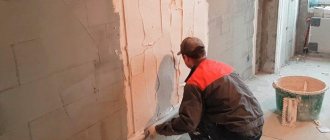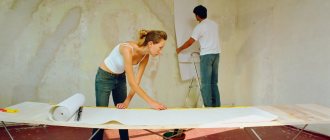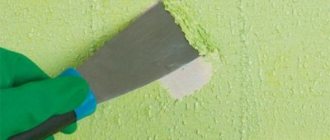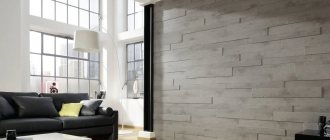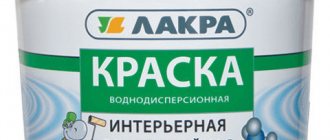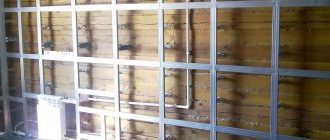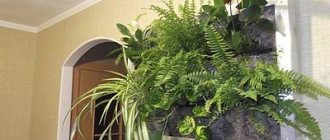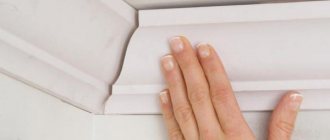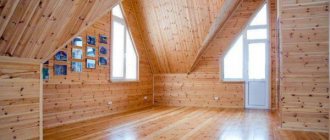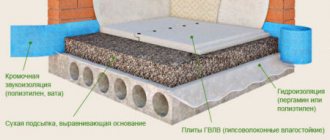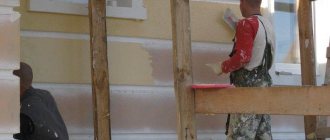Why do you need to level the walls?
Surfaces must be prepared before any finishing work. Leveling eliminates visual defects, improves the adhesion of walls to cladding, and increases the service life of the finishing materials used. If you skip this stage, then the existing depressions and bumps will lead to cracking, deformation, and disruption of the integrity of the cladding. In addition, it is difficult to paste wallpaper on uneven walls; it will be impossible to decorate them with stone or tiles.
Wallpaper with the right pattern
Wallpaper - yes! If they are non-woven or vinyl, then they are dense and multi-layered enough to hide unevenness. If such wallpaper overlaps when pasted, the excess at the joint can be carefully trimmed with a utility knife. This will not work with thin paper wallpaper.
Paint or wallpaper, which is better for your walls?
Wallpaper is a favorite of Russian interiors, but painted walls are a rare guest in our apartments. Maybe it's time to take a closer look at them or continue to remain faithful to traditions?
We immediately reject plain, smooth, thin wallpaper, which accentuates even minor surface defects, as well as canvases with a shiny tint. We say “no” to clear geometric patterns, especially longitudinal lines, and any prints that require perfect joining.
The best option would be a print that does not require adjustment of the ornament: for example, abstraction, watercolor blur, animalistic pattern, asymmetrical floral pattern, photo imitation of other finishing materials.
Alignment methods
- The raw method using plaster or putty is for small defects. The method involves carefully sealing existing cracks and holes with a special compound, followed by smoothing out possible defects.
- Dry method using drywall or other sheet materials - with strong curvature. The slabs are attached to a prepared frame or directly to the wall surface.
Materials
- Functional mixtures. Irregularities are sealed using different types of plaster. It is suitable for differences of up to 3-5 cm. Putty - for depressions of up to 0.5-1 cm.
- Sheet materials. To level the walls, use plywood, lining, PVC boards, MDF or plasterboard. The last type of material is the most popular. Use it for unevenness of more than 5 cm.
Building mixtures for leveling walls
It’s difficult not to get confused when choosing a building composition – there are a great variety of them in stores: from simple alabaster to decorative plaster. It is important to know what qualities a particular material has, whether it can be applied outside the house or just to level the walls in the apartment.
Plaster
Powdered compounds will help level out curved walls inside a building. The mixtures contain various plasticizers, thanks to which the plaster lies evenly on the surface. Plaster is convenient for leveling brick or concrete walls. It is not recommended to use it for building facades, wet rooms - saunas, bathrooms, swimming pools.
Advantages:
- elastic compositions with fine texture;
- adheres well to different surfaces;
- do not require finishing putty;
- harden quickly (you can begin finishing finishing in a week).
- have soundproofing properties.
Flaws:
- not suitable for exterior decoration of building walls;
- set within 45 minutes, which is not very convenient during work;
- lose their quality in damp areas;
- are relatively expensive.
Cement
These mixtures will help to repair serious unevenness and level a concrete wall inside or outside the room. The composition contains cement and sand of different fractions. To increase plasticity, lime is added. Mixtures with coarse sand help to repair serious defects, while cement-lime mixtures with fine sand are used for finishing the surface.
Advantages:
- cheaper than gypsum compounds;
- suitable for wet areas;
- evenly distributed on the surface.
Flaws:
- may crack over time;
- have low adhesion, especially with concrete;
- harden for a long time - you can begin final finishing in 20–30 days;
- They do not have a very smooth texture, so additional grinding or application of a more plastic and fine-grained solution is required.
Clay
An environmentally friendly, safe and affordable type of plaster. The mixtures are made on a clay basis, mixed with sawdust, chopped straw and other natural materials, and applied before chalk or lime whitewash. Finally, the surface is leveled by grinding or fine-grained clay plaster.
Advantages:
- maintain warmth indoors in cold weather;
- keep cool in summer.
Flaws:
- No.
Thermal insulation
The mixtures are made on a cement-lime base with the addition of polystyrene foam balls and perlite. The low thermal conductivity of the composition elements helps to accumulate and retain heat indoors even with sudden temperature changes. To increase the heat-saving properties, the plaster must be applied in a thick layer.
Advantages:
- It is convenient to work with lightweight compounds;
- no additional insulation is needed.
Flaws:
- the solution absorbs a lot of water and sets quickly, so it must be mixed in small portions;
- due to the lightness of the composition, it is not durable after hardening.
How to hide a crooked corner: surprise, and that’s all
Not every new building can boast of ideal walls and corners, let alone the old building. But nowadays every problem has a solution. There are several ways to disguise a crooked corner so that guests don’t even think that there are problems in this area of the apartment.
Shelves with interesting figurines and souvenirs on them will distract attention from defects.
You can decorate the corner with pictures or photo frames with the best shots from your life.
Artificial stone, brick or other decorative material is an excellent solution to the problem.
The unevenness of the corner will be well hidden by striped wallpaper, which will visually distract attention from it.
Sheet materials for leveling walls
In repair work, you don’t always want to bother with mixing different components - it’s time-consuming, dirty, and you need to be able to apply it evenly. It’s easier and faster to level the walls with ready-made slabs. To do this, you should arm yourself with a drill, screws for the frame method, or strong glue for the frameless method.
Drywall
The material is often used to level different surfaces inside a building, to create partitions and all kinds of decorative elements. The main component of the material is gypsum filler. Cardboard, surfactants, and starch are used as additives in production.
Advantages:
- environmentally friendly, safe material;
- There are many colors and coatings available on sale;
- easy to process.
Flaws:
- fragile;
- is destroyed upon contact with moisture (if the material is not moisture resistant);
- unstable to temperature changes;
- Suitable only for interior cladding.
Frame method
The method is relevant to use for large curvature of surfaces. It is suitable if you need to hide communications behind drywall, additionally insulate or soundproof a room. Before installation, keep in mind that the frame will take up part of the free space, so calculate the working area in advance.
- Sterilizer for manicure instruments
- Chicken fillet in creamy sauce: recipes
- How to get rid of wen on the body
Wall leveling consists of three stages:
- Creating a frame. The profile for mounting on walls can be wooden or metal.
- If necessary, fill the frame with communications, heat and sound insulating material.
- Installation of drywall.
Frameless method
This installation helps to quickly level the wall surface. It is suitable for masking slight curvature - possible level differences from 2 to 5 cm. Work should be carried out at an air temperature of at least 10 degrees. Drywall sheets must remain in the room for at least two days.
Sequence of work:
- Clean the walls from dirt and prime them.
- Cut out the drywall.
- Mark on the ceiling and floor where the sheets will be located.
- Apply adhesive to the drywall in spots.
- Press the sheet against the wall.
- Install the remaining sheets of drywall according to the markings.
Gypsum fiber
GVL sheets are made from pressed reinforced gypsum and paper. Externally, the material is similar to drywall, but unlike it, it is not covered with cardboard, just as the former may or may not be moisture resistant. For rooms with high humidity, it is recommended to use GVLV slabs.
Advantages:
- withstands severe mechanical loads;
- can be used in cold rooms;
- keeps warm;
- practically does not burn.
Flaws:
- high price;
- the surface must be treated with putty.
Panels
If the walls have a large curvature horizontally and vertically, it is better to use sheathing. This type of finishing is recommended when it is necessary not only to mask defects, but also to insulate the room and provide good sound insulation. The materials are very durable, resistant to high moisture and mechanical stress.
Chipboard
The boards are produced by hot pressing of wood shavings with thermoactive resins - their quantity can be from 6 to 18%. The less of the latter there is in a material, the safer it is for health. For wall cladding, it is better to purchase fully lined slabs.
Advantages:
- durable material;
- has a homogeneous structure;
- easy to process - cut, saw.
Flaws:
- deforms upon contact with moisture;
- does not hold nails and screws well.
PVC
The sheets are made from polyvinyl chloride, a safe synthetic material. The panels can be decorative, laminated or varnished. PVC with patterns should be used in dark rooms, as the pattern quickly fades in the light. Lacquered panels can be used anywhere, they are not afraid of sunlight, and are resistant to scratches or cracks.
Advantages:
- There are many different colors on sale;
- the material is simply processed;
- resistant to external adverse factors, including high humidity.
Flaws:
- breaks down in the sun.
MDF
The boards are made from wood chips by dry pressing. The material differs in that it contains lignin, a natural polymer found in wood. It makes MDF boards resistant to damage by fungi and other microorganisms.
Advantages:
- retains its original qualities in almost any conditions;
- moisture and fire resistant;
- holds screws and nails well.
Flaws:
- sawing produces dust that is harmful to health.
Why is it necessary to prepare the surface before gluing?
Often, in order to save time, wallpaper is glued without first preparing the wall. This is fraught with some inconveniences. So, the unevenness of the wall can be clearly visible even to someone who comes to visit for the first time. And if new material is pasted over old wallpaper, after a certain period of time, streaks may appear on the coating, or the pasted room will be spoiled by the pattern that has appeared, so preparing the wall for wallpapering is carried out to achieve the following goals:
- The prepared surface becomes porous before gluing. This allows you to ensure reliable attachment of the material. In addition, this eliminates the possibility of unpleasant surprises in the form of unstuck seams.
- During preparation, cracks are covered, recesses are hidden under a layer of putty, and protrusions are removed, which is often required in a panel house. This process not only improves the aesthetic effect of the renovation, but also fulfills practical properties. Thus, sealing defects increases sound insulation and allows the room to better retain heat.
- Such restoration is especially important for those structures that are in contact with the street. After the preparatory work, the flow of cold air from outside into the apartment will be reduced, which will protect the room from fungus and mold.
- Uneven surfaces can cause rubbing or other damage to the wallpaper.
Although preparing walls for wallpapering can increase the repair time, it will make it better, and the service life of the coating will increase from 5 years to 10 or more, but to achieve the result you need to follow the correct sequence of work.
